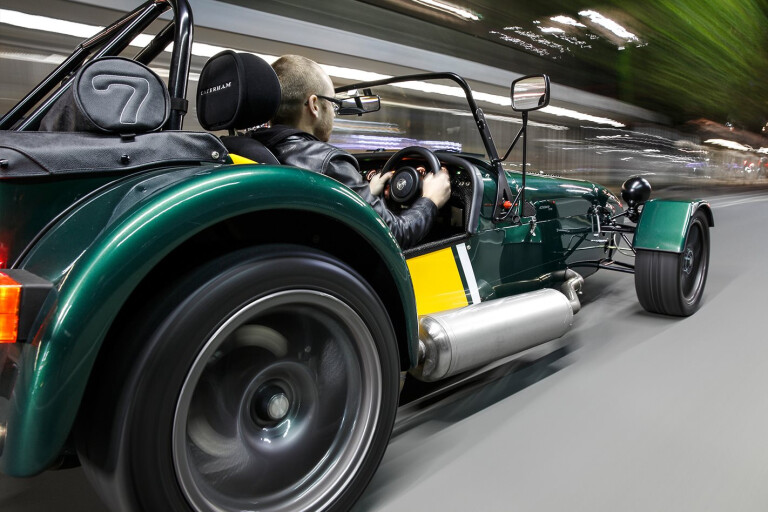
A while back I wrote in my editorial, “bring on the electronics in performance cars!”
If I had dribbled more twaddle I would have needed a bib. In fact, I should run for parliament.
It took just 20 minutes in the Caterham CSR 175 – my first Caterham experience – for me to pull over and swiftly clobber myself over the back of the head. And after seven hours belting the little Caterham, with no ABS, no ESP, no power steering, not even power-assisted brakes, not only did I feel like I’d just been through an SAS training camp, but I felt enlightened to the world devoid of electronics.
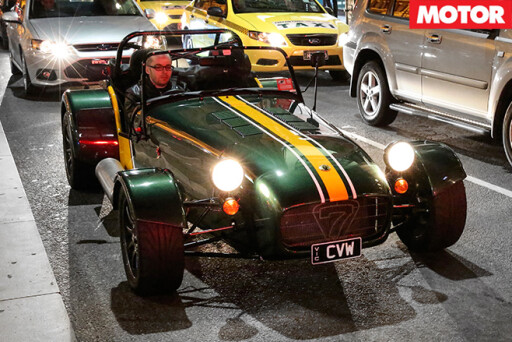 We were given the chance to reacquaint ourselves with the Caterham and, can you blame us, we grabbed it with two grubby mittens.
We were given the chance to reacquaint ourselves with the Caterham and, can you blame us, we grabbed it with two grubby mittens.
The car you see here, the CSR 175, comes with Ford’s 2.0-litre Duratec naturally-aspirated four-pot donk. It’s got 127kW and 177Nm, which doesn’t sound much but, then again, this thing weighs 625kg. Good enough for 0-100km/h in a claimed 4.5 seconds.
Of course, if you look over to the corner of the room, behind the lampshade you’ll see an elephant trying to hide: the price, $89,990 in the CSR 175’s case. Sorry if we startled you, but you might even get upset, like us, when you consider in the UK, you can wriggle yourself into the simply mad 620R, the halo model, for A$90,150 (directly converted).
Think 232kW, 297Nm, 495kg, a power-to-weight ratio more than a Bugatti Veyron or McLaren F1, in a car that looks like a shoe and really should be locked in a room with padded walls.
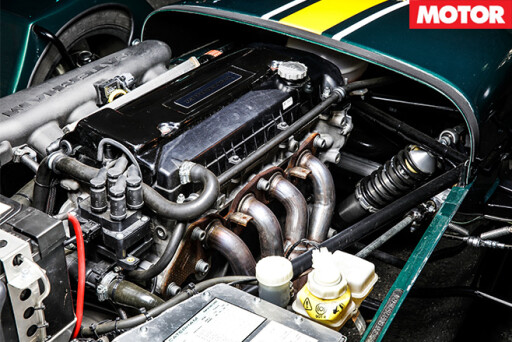 It comes with a full-on sequential ’box and is bedecked in carbonfibre. It does 0-100km/h in 2.9 seconds but some Pom car journos have said this is a “conservative” figure. Gulp.
It comes with a full-on sequential ’box and is bedecked in carbonfibre. It does 0-100km/h in 2.9 seconds but some Pom car journos have said this is a “conservative” figure. Gulp.
So why is the Caterham so expensive in Australia? We’ll come back to that. For now, let’s sink throttle into firewall.
But don’t be misled by the pics, we’re not using Melbourne’s CBD as a giant motorkhana, as fun as that would be. We shot the Caterham in Melbourne in the middle of the night, in the middle of winter, but saved the driving impressions for a blat in the hills to Melbourne’s east.
And thank god for that because, frankly, the Caterham is suited to the city like Clive Palmer is suited to bikinis. We’ll speculate you’ll have better odds of survival going base jumping than driving a Caterham around in the city. Being about as tall as a skateboard, you feel like you need a fluoro flag on a bendy pole so that even Commodore drivers don’t merge into you. Got a Caterham? Keep away from CBDs.
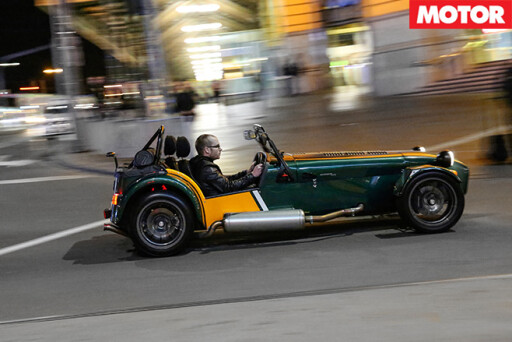 It’s also the one car you would happily ditch for public transport for any long journeys.
It’s also the one car you would happily ditch for public transport for any long journeys.
The Caterham has all the NVH of a Spitfire; two hours on a coarse-chip Aussie road in the Caterham is equivalent to six in a Toyota 86. It wears you out.
Fortunately, though, evaluating the Caterham for its city sensibilities and long-haul comfort is like complaining your mountain bike is a horrendous coffee table.
The interior is merely an interface to driving fast. You climb into the Caterham with a motion that wouldn’t look out of place on a yoga curriculum. And when you’re in it, one thing is for sure: it’s not for big blokes. Even for me, an average-sized chap, sitting in the Caterham you feel like a foot in a tightly-laced shoe.
Everything in the interior is miniaturised like it’s come from a scale model. The steering wheel is so small it’s like steering with a bagel. Storage space? You’ll find more nooks and crannies for stashing things in a pair of jeans.
The pedals, meanwhile, feel arranged like piano keys under your feet and have pads the size of postage stamps. I dip the heavy clutch, which feels like it has about five centimetres of travel, and turn the Caterham over. It starts and settles to a fizzing idle.
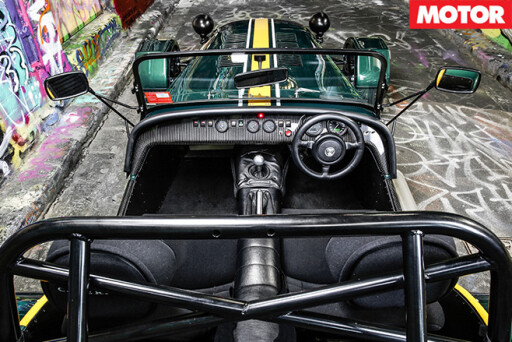 Grab first gear and you’ll find a tight, mechanical gearbox with a throw that feels two centimetres across the gate. It’s extremely short and tight, but heavy and physical. It matches the clutch, which bites quickly and aggressively as you let it out. We’re away.
Grab first gear and you’ll find a tight, mechanical gearbox with a throw that feels two centimetres across the gate. It’s extremely short and tight, but heavy and physical. It matches the clutch, which bites quickly and aggressively as you let it out. We’re away.
All the controls are super heavy, which takes some getting used to in a car that weighs the same as your average American labrador. The steering is around 2.4 turns lock-to-lock which means, with that toy steering wheel, you’re gonna get forearms like thighs cranking those front 195s.
Time to boot it. Throttle pinned, the Caterham shreds its cold rear Avon 245s easily, the optional LSD feeling nice and tight. One skill you’ll certainly become an expert at even in the 127kW Caterham is throttle modulation.
The Caterham shreds first gear and booms a Honda-VTEC-meets-BDA-Escort, four-cylinder roar as it charges towards its 7500rpm limiter. Kiss the clutch, slot second gear in one quick, mechanical flash. A second later, redline. Third gear. Two seconds later, fourth gear. Wind noise fights the engine for attention, even with those insanely close gears keeping it in its roaring power band like a sportsbike. The diff whines like there’s a dogbox in the boot. Speed? We didn’t look down, but it was a lot, and quickly.
Although its power output ain’t much, this thing hauls. Hard. It doesn’t have the sheer mid-range of something with a turbo – as we’re starting to get used to – but it also doesn’t run out of lungs as you wind towards redline. Just a linear, progressive thrust available the entire tacho and sounding more and more glorious the further clockwise you wind.
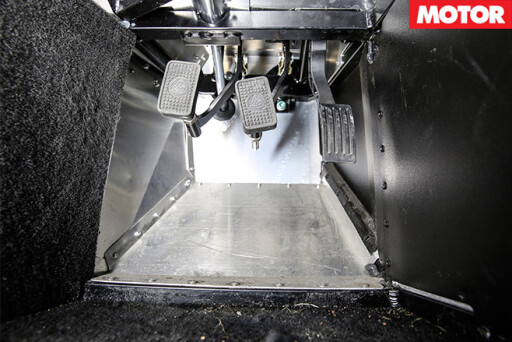 First corner, hit the brakes. Oh dear. With no assistance, the brake pedal is numb and lacks sensitivity; it bites without teeth, just gums. You need to press it hard and, without ABS, you become super attuned to the pedal feel, worrying you’ll pinch a brake. But it doesn’t matter how hard you step on the pedal, it’s extremely difficult to lock a wheel.
First corner, hit the brakes. Oh dear. With no assistance, the brake pedal is numb and lacks sensitivity; it bites without teeth, just gums. You need to press it hard and, without ABS, you become super attuned to the pedal feel, worrying you’ll pinch a brake. But it doesn’t matter how hard you step on the pedal, it’s extremely difficult to lock a wheel.
And after you’ve become acclimatised to the lack of assistance, the feel through the pedal is tremendous and beautifully communicative.
In fact, the only thing stopping you, pardon the pun, from big stop after big stop are the muscles in your right leg. It’s hard work. With its heavy steering, heavy clutch and heavy gearchange, the Caterham would be a physical experience on a track.
Braking over, time to tip in. Turn the tiny steering wheel and the Caterham goes where you point it with insect accuracy. The steering is heavy, particularly when loaded up mid-corner, and just the sheer physical exertion makes it tricky at first to also feel what the front wheels are doing. But like the brakes, once acclimatised, the feel – and weighting – is sublime.
 Having said all this, it took me and the Caterham a while to click. You see, every car that visits MOTOR these days has a little something called ESP. I’ve become used to the safety net – rock climbing with the harness, if you like.
Having said all this, it took me and the Caterham a while to click. You see, every car that visits MOTOR these days has a little something called ESP. I’ve become used to the safety net – rock climbing with the harness, if you like.
But driving the Caterham was like doing complex mathematics – without a calculator. There’s a certain thrill and satisfaction to solving complex algebraic equations using merely the sinews of your brain (or maybe that’s just me). Driving the Caterham was a similar sensation: connecting with the raw basics of driving all over again.
The revelation for me was relearning throttle modulation, a skill that had atrophied in my mind. Modern traction controls are becoming so good, you just leave it on, pin the throttle and it does all the work. Not in the Caterham.
At first I was extremely cautious feeding in throttle, aware there was no ESP to rescue me if I very likely stuffed it all up. But as I got more and more confident, feeding in throttle more aggressively, I was pleased to find impressive rear traction from the Avon rubber – and, depending on how much lateral load you’re carrying, the exact point of throttle travel at which you could unstick the rears.
When I discovered this point it was epiphanic, like I had seen the light (although that might have been the dashboard reflecting the sun straight into my eyes). I felt like a hero, hanging the arse out after every apex in addictive mini-drifts in all of first, the top of second and even third if you’re brave enough (I rarely was). The diff locks quickly and predictably, boosting confidence to get stuck into the throttle. It will cause out-loud laughing, guaranteed.
 The lithe rack makes correcting oversteer just a flick of the wrists, too, and since you’re practically sitting on the rear axle (the driver’s side rear wheel inches from buttock) and behind the car’s pivot point, it becomes easy to detect even the slightest of rearward wriggles.
The lithe rack makes correcting oversteer just a flick of the wrists, too, and since you’re practically sitting on the rear axle (the driver’s side rear wheel inches from buttock) and behind the car’s pivot point, it becomes easy to detect even the slightest of rearward wriggles.
Something else worth mentioning is the ride. Unfortunately with solid-mounted suspension you feel every single bump, but it’s not as bad as you might first think. From the driver’s seat you have a brilliant view of the front wheels working the bumps – the high-speed damping, even loaded-up mid-corner, is just awesome.
Although the Caterham deals surprisingly well with Australia’s bumpy mountain roads, I did have more fun when I found smoother bitumen that made me feel more confident trying to find where the grip ran out. Sure, there’s shitloads of it, but when you feel like you’ve got the testes to push beyond the limit, you’ll encounter gentle mid-corner understeer easily transferable to oversteer with a dollop of gas.
The Caterham punishes poor driving, too, but not in a scary way. Pick up the throttle too early and oops, gentle understeer. Pick it up too hard and oversteer, again. Oops...
Basically, I haven’t had this much fun in a car in a long time. After my first drive in the Caterham through the city, I couldn’t wait to get out of it. After my first drive through the hills, I didn’t want to get out of it. In fact, I reckon I learnt more about driving in the seven hours I drove the Caterham than I did in 90-odd laps of Winton in 22 cars as a judge at Bang For Your Bucks this month.
It’s hard work but satisfyingly mechanical and a real challenge to drive; even if I got nowhere near driving it “well”.
So, back to the elephant behind the lampshade: the price. We said earlier the CSR 175 costs $89,990. Unfortunately, in fact it’s $106,360 as-tested. Or a lot for a car with a missile switch for an indicator stalk.
 Indeed, for just $740 more you can get yourself a base, manual Porsche Cayman.
Indeed, for just $740 more you can get yourself a base, manual Porsche Cayman.
Why so much? In the UK compliance regulations are more relaxed, which has helped small vehicle manufacturers survive. In Australia, they’re much tighter, meaning compliance gets expensive.
Then there’s freight, and tax. A lot of tax. Cars over 1.6 litres cop five per cent import duty. Then there’s 33 per cent luxury car tax. Aussie Caterhams come with the full weather kit (the tent Caterham calls a roof) and heater standard, too – optional in England, bizarrely.
Then you have to factor in other costs of Caterham ownership. If your partner merely tolerates your car hobby, they’ll despise the noisy, rough-riding Caterham. And it’s true only those destined for the asylum would use a Caterham for commuting. So you’ll need a second car. And a garage to put the Caterham in, let’s be honest.
Suddenly the Caterham has become one frighteningly expensive toy. But by golly, take it for a decent blat and you’ll be grinning like a loon. I was. And I promise to never egg on electronics again.
Specs:
Body: 2-door, 2-seat roadster
Drive: rear-wheel
Engine: 1999cc inline-4, DOHC, 16v
Bore/stroke: 87.5 x 83.1mm
Compression: 13.0:1
Power: 127kW @ 8500rpm
Torque: 177Nm @ 6300rpm
Power/weight: 203kW/tonne
Consumption: 7.7L/100km (claimed)
CO2 Emissions: 182g/km (claimed)
Transmission: 6-speed manual
Weight: 625kg
Suspension: A-arms, pushrods, coilovers, anti-roll bar (f); A-arms, coilovers (r)
L/W/H: 4988/1685/1115mm
Wheelbase: 2305mm
Tracks: 1473mm (f/r)
Steering: rack and pinion
Brakes: 254mm ventilated discs, four-piston calipers (f); 254mm solid discs, single-piston calipers (r)
Wheels: 15 x 6.0-inch (f); 15 x 9.0-inch (r)
Tyres: 195/45 VR15 (f); 245/40 VR15 (r) Avon CR500
Price: $89,990
Price as tested: $106,360*
6-speed manual ($6865), LSD ($2860), carbon fibre dash ($645), carbon front wings ($890). front wings painted ($260), track day battery ($630), battery master switch ($395), Metallic paint F1 livery ($3860), 12-volt power socket ($230), Push button ($120)
Positives: Drives like an extension of yourself...
Negatives: ...which can be taxing, and annoying

COMMENTS